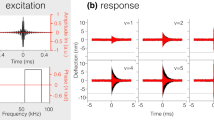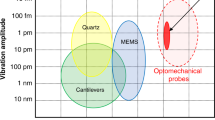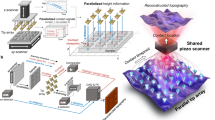Abstract
Tapping-mode atomic force microscopy (AFM), in which the vibrating tip periodically approaches, interacts and retracts from the sample surface, is the most common AFM imaging method. The tip experiences attractive and repulsive forces that depend on the chemical and mechanical properties of the sample, yet conventional AFM tips are limited in their ability to resolve these time-varying forces. We have created a specially designed cantilever tip that allows these interaction forces to be measured with good (sub-microsecond) temporal resolution and material properties to be determined and mapped in detail with nanoscale spatial resolution. Mechanical measurements based on these force waveforms are provided at a rate of 4 kHz. The forces and contact areas encountered in these measurements are orders of magnitude smaller than conventional indentation and AFM-based indentation techniques that typically provide data rates around 1 Hz. We use this tool to quantify and map nanomechanical changes in a binary polymer blend in the vicinity of its glass transition.
This is a preview of subscription content, access via your institution
Access options
Subscribe to this journal
Receive 12 print issues and online access
$259.00 per year
only $21.58 per issue
Buy this article
- Purchase on Springer Link
- Instant access to full article PDF
Prices may be subject to local taxes which are calculated during checkout






Similar content being viewed by others
References
Yamanaka, K., Ogiso, H. & Kolosov, O. Ultrasonic force microscopy for nanometer resolution subsurface imaging. Appl. Phys. Lett. 64, 178–180 (1994).
Maivald, P. et al. Using force modulation to image surface elasticities with the atomic force microscope. Nanotechnology 2, 103 (1991).
Ge, S. et al. Shear modulation force microscopy study of near surface glass transition temperatures. Phys. Rev. Lett. 85, 2340–2343 (2000).
Dinelli, F., Buenviaje, C. & Overney, R. M. Glass transition measurements on heterogeneous surfaces. Thin Solid Films 396, 138–144 (2001).
Oliver, W. C. & Pharr, G. M. An improved technique for determining hardness and elastic-modulus using load and displacement sensing indentation experiments. J. Mater. Res. 7, 1564–1583 (1992).
Vanlandingham, M. R. et al. Nanoscale indentation of polymer systems using the atomic force microscope. J. Adhesion 64, 31–59 (1997).
Zhong, Q., Inniss, D., Kjoller, K. & Elings, V. B. Fractured polymer/silica fiber surface studied by tapping mode atomic force microscopy. Surf. Sci. 280, L688–L692 (1993).
Klinov, D. & Magonov, S. True molecular resolution in tapping-mode atomic force microscopy with high-resolution probes. Appl. Phys. Lett. 84, 2697–2699 (2004).
Cleveland, J. P., Anczykowski, B., Schmid, A. E. & Elings V. B. Energy dissipation in tapping-mode atomic force microscopy. Appl. Phys. Lett. 72, 2613–2615 (1998).
Paulo, A. S. & Garcia, R. Unifying theory of tapping-mode atomic force microscope Phys. Rev B. 66, 041406 (2002).
Hillenbrand, R., Stark, M. & Guckenberger, R. Higher-harmonics generation in tapping-mode atomic-force microscopy: Insights into the tip–sample interaction. Appl. Phys. Lett. 76, 3478–3480 (2000).
Stark, R. W. & Heckl, W. M. Fourier transformed atomic force microscopy: tapping mode atomic force microscopy beyond the Hookian approximation. Surf. Sci. 457, 219–228 (2000).
Crittenden, S., Raman, A. & Reifenberger, R. Probing attractive forces at the nanoscale using higher-harmonic dynamic force microscopy. Phys. Rev. B 72, 235422 (2005).
Legleiter, J., Park, M., Cusick, B. & Kowalewski, T. Scanning probe acceleration microscopy (SPAM) in fluids: mapping mechanical properties of surfaces at the nanoscale. Proc. Natl Acad. Sci. USA 103, 4813–4818 (2006).
Hembacher, S., Giessibl, F. J. & Mannhart, J. Force microscopy with light-atom probes. Science 305, 380–383 (2004).
Stark, M., Stark, R. W., Heckl, W. M. & Guckenberger, R. Inverting dynamic force microscopy: from signals to time-resolved interaction forces. Proc. Natl Acad. Sci. USA 99, 8473–8478 (2002).
Rodriguez, T. R. & Garcia, R. Tip motion in amplitude modulation (tapping-mode) atomic-force microscopy: comparison between continuous and point-mass models. Appl. Phys. Lett. 80, 1646–1648 (2002).
Stark, R. W. Optical lever detection in higher eigenmode dynamic atomic force microscopy. Rev. Sci. Instrum. 75, 5053–5055 (2004).
Stark, R. W., Schitter, G., Stark, M., Guckenberger, R. & Stemmer, A. State-space model of freely vibrating and surface-coupled cantilever dynamics in atomic force microscopy. Phys. Rev. B 69, 085412 (2004).
Zitzler, L., Herminghaus, S. & Mugele, F. Capillary forces in tapping-mode atomic force microscopy Phys. Rev. B 66, 155436 (2002).
Isrelachvili, J. Intermolecular and Surface Forces (Academic Press, London, 2003).
Luan, B. Q. & Robbins, M. O. The breakdown of continuum models for mechanical contacts. Nature 435, 929–932 (2005).
Stark, R. W. & Heckl, W. M. Higher harmonics imaging in tapping-mode atomic-force microscopy. Rev. Sci. Instrum. 74, 5111–5114 (2003).
Sahin, O. et al. High-resolution imaging of elastic properties using harmonic cantilevers. Sensor. Actuat. A 114, 183–190 (2004).
Sahin, O., Atalar, A., Quate, C. F. & Solgaard, O. Resonant harmonic response in tapping-mode atomic force microscopy. Phys. Rev. B. 69, 165416 (2004).
Garcia, R. et al. Identification of nanoscale dissipation processes by dynamic atomic force microscopy. Phys. Rev. Lett. 97, 016103 (2006).
Ward, I. M. & Sweeney, J. An Introduction to the Mechanical Properties of Solid Polymers (Wiley, Chichester, 2004).
Dinelli, F., Buenviaje, C. & Overney, R. M. Glass transitions of thin polymeric films: speed and load dependence in lateral force microscopy. J. Chem. Phys. 113, 2043–2048 (2000).
Acknowledgements
We thank N. Yerina of Veeco Instruments for preparing the polymer samples. The authors acknowledge support from the Center for Probing the Nanoscale (CPN), and NSF NSEC, NSF Grant No. PHY-0425897. O. Sahin acknowledges support from the Rowland Junior Fellows Program.
Author information
Authors and Affiliations
Corresponding author
Ethics declarations
Competing interests
A patent application has been filed by Stanford University.
Supplementary information
Supplementary Information
Supplementary figures S1–S3 (PDF 354 kb)
Rights and permissions
About this article
Cite this article
Sahin, O., Magonov, S., Su, C. et al. An atomic force microscope tip designed to measure time-varying nanomechanical forces. Nature Nanotech 2, 507–514 (2007). https://doi.org/10.1038/nnano.2007.226
Received:
Accepted:
Published:
Issue Date:
DOI: https://doi.org/10.1038/nnano.2007.226
This article is cited by
-
Interaction of the fundamental frequencies of a torsional cantilever nanobeam and spring mass system single degree of freedom (SDOF) under axial load, including buckling
SN Applied Sciences (2023)
-
Dynamic Behavior of Rectangular Atomic Force Microscope Cantilever by Supposing Diverse Polymeric Specimens and Immersion Media
Journal of Vibration Engineering & Technologies (2022)
-
Force spectroscopy of single cells using atomic force microscopy
Nature Reviews Methods Primers (2021)
-
Cellular nanoscale stiffness patterns governed by intracellular forces
Nature Materials (2019)
-
A comprehensive model for transient behavior of tapping mode atomic force microscope
Nonlinear Dynamics (2019)



